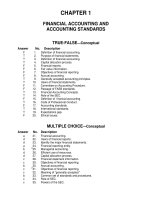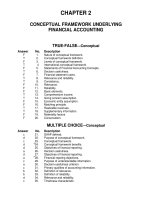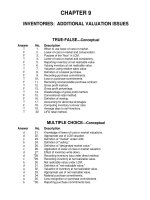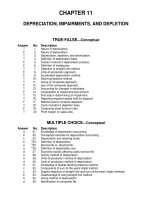Intermediate accounting 16e by kieso slide ch15
Bạn đang xem bản rút gọn của tài liệu. Xem và tải ngay bản đầy đủ của tài liệu tại đây (2.75 MB, 86 trang )
15-1
PREVIEW OF CHAPTER 15
Intermediate Accounting
16th Edition
Kieso ● Weygandt ● Warfield
15-2
15
Stockholders’ Equity
LEARNING OBJECTIVES
After studying this chapter, you should be able to:
1
Describe the corporate form and the issuance of
3
shares of stock.
2
Describe the accounting and reporting for reacquisition of
Understand the accounting and reporting issues related
to dividends.
4
Indicate how to present and analyze stockholders’ equity.
shares.
15-3
LO 1
CORPORATE CAPITAL
Three primary forms of business organization
Proprietorship
Partnership
Corporation
Special characteristics of the corporate form:
15-4
1.
Influence of state corporate law.
2.
Use of capital stock or share system.
3.
Development of a variety of ownership interests.
LO 1
CORPORATE CAPITAL
State Corporate Law
Corporation must submit articles of incorporation to the state in which incorporation is desired.
State issues a corporation charter.
Advantage to incorporate in a state whose laws favor the corporate form of business organization.
►
15-5
Delaware
Accounting for stockholder’s equity follows the provisions of each state’s business incorporation act.
LO 1
WHAT DO THE NUMBERS MEAN?
1209 NORTH ORANGE STREET
WHAT’S YOUR PRINCIPLE
Nothing about 1209 North Orange Street hints at the secrets inside. It’s a humdrum office building, a low-slung affair with a faded awning and a
view of a parking garage. Hardly worth a second glance, if even a first one. But behind its doors is one of the most remarkable corporate
collections in the world: 1209 North Orange, you see, is the legal address of no fewer than 285,000 separate businesses.
Its occupants, on paper, include giants like American Airlines, Apple, Bank of America, Berkshire Hathaway, Cargill, Coca-Cola,
Ford, General Electric, Google, JPMorgan Chase, and Wal-Mart. These companies do business across the nation and around the world. Here
at 1209 North Orange, they simply have a dropbox. What brings these marquee names to 1209 North Orange, and to other Delaware
addresses, also attracts less-upstanding corporate citizens. For instance, 1209 North Orange was, until recently, a business address of Timothy
S. Durham, known as “the Midwest Madoff.” Recently, Durham was found guilty of bilking 5,000 mostly middle-class and elderly investors out of
$207 million. It was also an address of Stanko Subotic, a Serbian businessman and convicted smuggler—just one of many Eastern Europeans
drawn to the state. Big corporations, small-time businesses, rogues, scoundrels, and worse—all have turned up at Delaware addresses in hopes
of minimizing taxes, skirting regulations, plying friendly courts, or, when
15-6
(continued)
LO 1
WHAT DO THE NUMBERS MEAN?
1209 NORTH ORANGE STREET
WHAT’S YOUR PRINCIPLE
needed, covering their tracks. Federal authorities worry that, in addition to the legitimate businesses flocking here, drug-traffickers, embezzlers,
and money-launderers are increasingly heading to Delaware, too. It’s easy to set up shell companies here, no questions asked.
Today, Delaware regularly tops lists of domestic and foreign tax havens because it allows companies to lower their taxes in another state
—for instance, the state in which they actually do business or have their headquarters—by shifting royalties and similar revenues to holding
companies in Delaware, where they are not taxed. In tax circles, the arrangement is known as “the Delaware loophole.” Over the last decade, the
Delaware loophole has enabled corporations to reduce the taxes paid to other states by an estimated $9.5 billion. However, recently some
companies are concerned that the environment in Delaware has become more hostile. Among their gripes: a growing tide of shareholder
litigation, for which some feel that the state has not done enough to curb. Only time will tell if these developments have soured companies on
Delaware as an incorporation target. Yet in the past two years, approximately 85 percent of the companies that went public incorporated in
Delaware.
Sources: L. Wayne, “How Delaware Thrives as a Corporate Tax Haven,” The New York Times (June 30, 2012); and L. Hoffman, “Dole and Other Companies Sour on Delaware as a
Corporate Haven,” Wall Street Journal (August 8, 2015).
15-7
LO 1
CORPORATE CAPITAL
Capital Stock or Share System
In the absence of restrictive provisions, each share carries the following rights:
15-8
1.
To share proportionately in profits and losses.
2.
To share proportionately in management (the right to vote for directors).
3.
To share proportionately in assets upon liquidation.
4.
To share proportionately in any new issues of stock of the same class—called the preemptive right.
LO 1
CORPORATE CAPITAL
Variety of Ownership Interests
Common stock is the residual corporate interest.
Bears ultimate risks of loss.
Receives the benefits of success.
Not guaranteed dividends nor assets upon dissolution.
Preferred stock is a special class of stock created by contract, when stockholders’ sacrifice certain rights in return
for other rights or privileges, usually dividend preference.
15-9
LO 1
CORPORATE CAPITAL
Common Stock
Common Stock
Account
Account
Additional Paid-in Capital
Additional Paid-in Capital
Contributed Capital
Contributed Capital
Account
Account
Preferred Stock
Preferred Stock
Account
Account
Two Primary Sources of
Equity
Retained Earnings
Retained Earnings
Account
Account
Assets – Liabilities =
Less:
Less:
Treasury Stock
Treasury Stock
Equity
Account
Account
15-10
LO 1
CORPORATE CAPITAL
Issuance of Stock
Shares authorized - Shares offered for sale - Shares issued
Accounting problems:
15-11
1.
Par value stock.
2.
No-par stock.
3.
Stock issued in combination with other securities.
4.
Stock issued in noncash transactions.
5.
Costs of issuing stock.
LO 1
CORPORATE CAPITAL
Par Value Stock
Low par values help companies avoid a contingent liability.
Corporations maintain accounts for:
15-12
Preferred Stock or Common Stock.
Paid-in Capital in Excess of Par (also called Additional Paid-in Capital)
LO 1
CORPORATE CAPITAL
Illustration: Blue Diamond Corporation issued 300 shares of $10 par value common stock for $4,500. Prepare the
journal entry to record the issuance of the shares.
Cash 4,500
Common Stock (300 x $10)
Paid-in Capital in Excess of Par Value
15-13
3,000
1,500
LO 1
CORPORATE CAPITAL
No-Par Stock
Reasons for issuance:
Avoids contingent liability.
Avoids confusion over recording par value versus fair market value.
A major disadvantage of no-par stock is that some states levy a high tax on these issues. In addition, in some states
the total issue price for no-par stock may be considered legal capital, which could reduce the flexibility in paying
dividends.
15-14
LO 1
CORPORATE CAPITAL
Illustration: Video Electronics Corporation is organized with authorized common stock of 10,000 shares without
par value. If Video Electronics issues 500 shares for cash at $10 per share, it makes the following entry.
Cash 5,000
Common Stock
15-15
5,000
LO 1
CORPORATE CAPITAL
Illustration: Some states require that no-par stock have a stated value. If a company issued 1,000 of the shares with
a $5 stated value at $15 per share for cash, it makes the following entry.
Cash 15,000
Common Stock
5,000
Paid-in Capital in Excess of Stated Value
15-16
10,000
LO 1
CORPORATE CAPITAL
Stock Issued with Other Securities (Lump-Sum)
Two methods of allocating proceeds:
15-17
1.
Proportional method.
2.
Incremental method.
LO 1
CORPORATE CAPITAL
Illustration: Beveridge Corporation issued 300 shares of $10 par value common stock and 100 shares of $50 par value
preferred stock for a lump sum of $13,500. Common stock has a market value of $20 per share, and preferred stock has
a market value of $90 per share.
Proportional Method
15-18
LO 1
CORPORATE CAPITAL
Prepare the journal
entry to record
issuance of shares.
Proportional Method
Cash 13,500
Preferred Stock (100 x $50)
5,000
Paid-in Capital in Excess of Par – Preferred
Common Stock (300 x $10)
3,000
Paid-in Capital in Excess of Par – Common
15-19
3,100
2,400
LO 1
CORPORATE CAPITAL
Illustration: Beveridge Corporation issued 300 shares of $10 par value common stock and 100 shares of $50 par value
preferred stock for a lump sum of $13,500. The common stock has a market value of $20 per share, and the value of
preferred stock is unknown.
Incremental Method
15-20
LO 1
CORPORATE CAPITAL
Prepare the journal
entry to record
issuance of shares.
Incremental Method
Cash 13,500
Preferred Stock (100 x $50)
5,000
Paid-in Capital in Excess of Par – Preferred
Common Stock (300 x $10)
3,000
Paid-in Capital in Excess of Par – Common
15-21
2,500
3,000
LO 1
CORPORATE CAPITAL
Stock Issued in Noncash Transactions
The general rule: Companies should record stock issued for services or property other than cash at
the
fair value of the stock issued or
fair value of the noncash consideration received,
whichever is more clearly determinable.
15-22
LO 1
CORPORATE CAPITAL
Illustration: The following series of transactions illustrates the procedure for recording the issuance of 10,000
shares of $10 par value common stock for a patent for Arganda Company, in various circumstances.
1.
Arganda cannot readily determine the fair value of the patent, but it knows the fair value of the stock is
$140,000.
Patents
140,000
Common Stock
100,000
Paid-in Capital in Excess of Par - Common
15-23
40,000
LO 1
CORPORATE CAPITAL
2.
Arganda cannot readily determine the fair value of the stock, but it determines the fair value of the patent is
$150,000.
Patents
150,000
Common Stock
100,000
Paid-in Capital in Excess of Par - Common
15-24
50,000
LO 1
CORPORATE CAPITAL
3.
Arganda cannot readily determine the fair value of the stock nor the fair value of the patent. An independent
consultant values the patent at $125,000 based on discounted expected cash flows.
Patents
125,000
Common Stock
100,000
Paid-in Capital in Excess of Par - Common
15-25
25,000
LO 1









